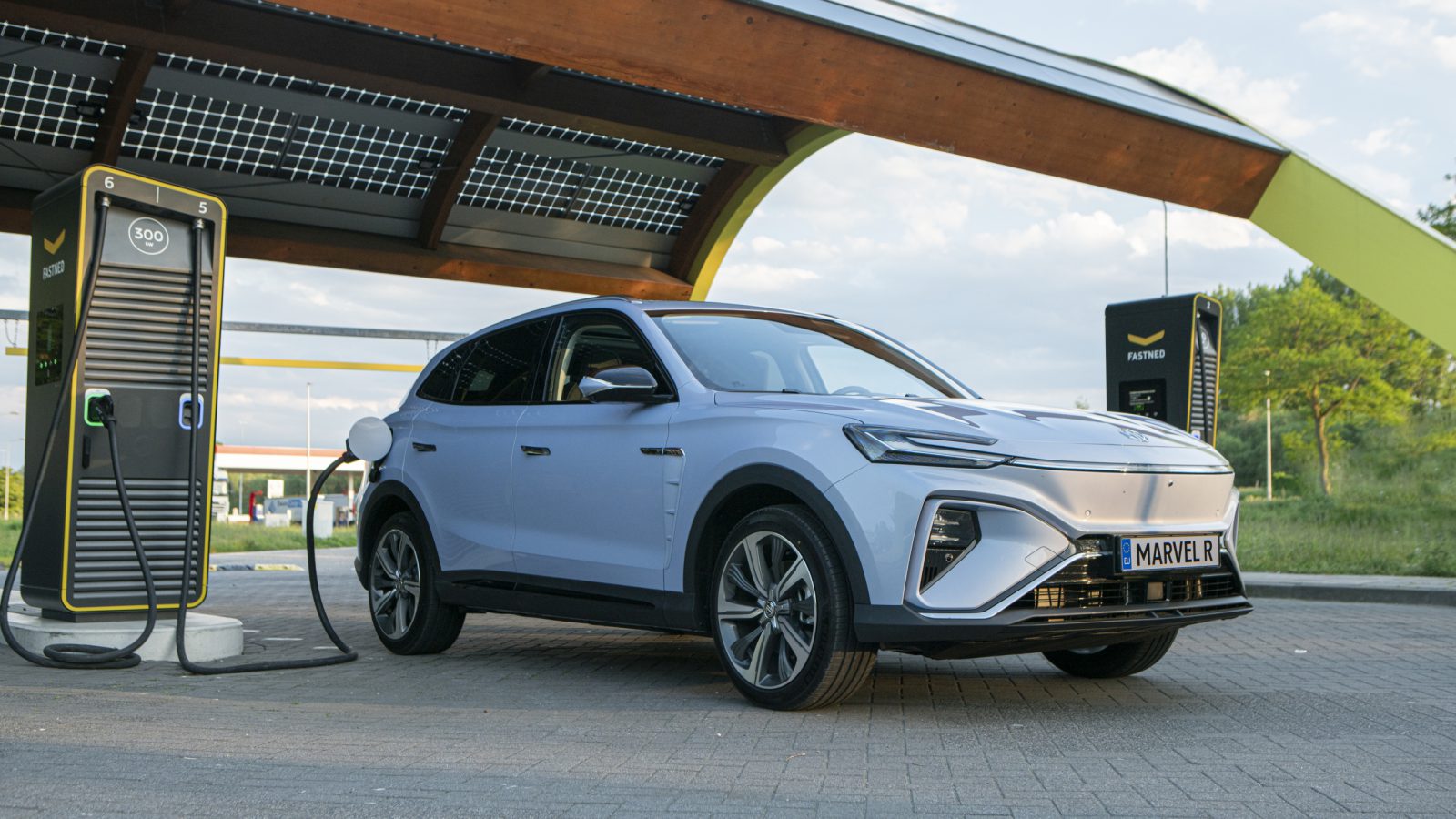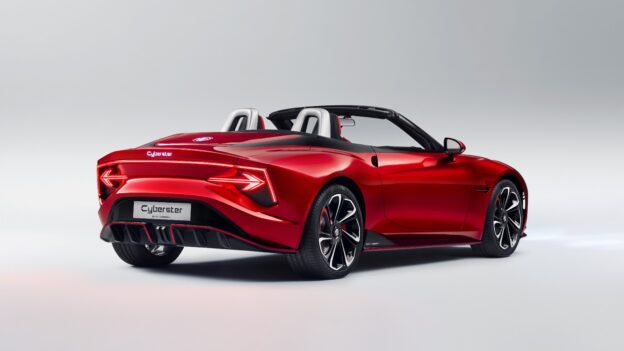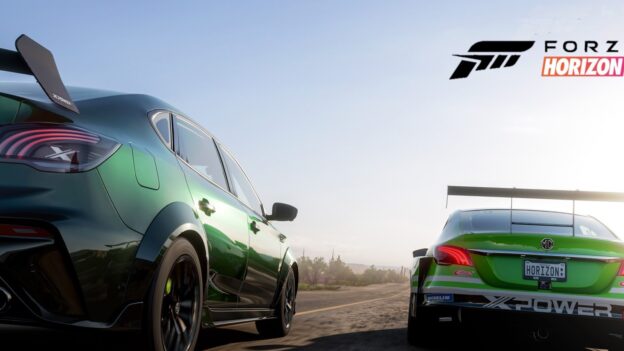Fast-charging with MG: how long does it really take?
The vast majority of public charging points in built-up areas, at home, in car parks and on business parks work with alternating current (AC). Depending on the connection to the electricity grid, the charging capacity varies between 2.3 kW (1-phase, 10 amps) and 22 kW (3-phase, 32 amps).
The so-called (ultra) fast-chargers, which you’ll mainly find along the motorway, work with direct current (DC) instead of alternating current (AC). In this case, the AC from the grid is converted to DC in the charging station. The inverter in the car is bypassed, allowing much higher charging capacities from 50 kW to well above 150 kW. This means the battery can be charged considerably faster compared with an AC charger.
Why only up to 80%?
Most electric cars, like all MG models, have a lithium-ion battery. A characteristic of this type of battery is that the charging speed decreases quite quickly when it is charged around 80%. You may recognize this from your smartphone that also has a lithium-ion battery.
Although the charging curve is different for every electric car, in general, fast-charging is no longer useful when the battery is charged to 80%. Therefore, the stated fast-charging times by EV manufacturers are always “up to 80% of the battery capacity”.
How long does fast-charging take?
The rate at which the battery actually charges at a fast-charging station depends on a number of factors:
– The battery capacity (in kWh)
– The maximum power which the fast-charger can deliver (in kW)
– The maximum fast-charging power which the battery can handle (in kW)
– The curve of the actual charging speed from 0-100%
– The temperature of the battery
The new-generation MG models, such as the MG Marvel R Electric and the renewed MG ZS EV, are suitable for fast-charging with a capacity of up to 92 kW as standard. This charging speed is only achieved if the charging station can deliver such power, like a 100 kW or 150 kW DC fast-charger which you’ll find more often across Europe.
However, a lithium-ion battery can’t continuously charge at maximum charging speed. Every electric car has a specific charging curve, depending on the EV manufacturer’s battery choices and external factors that may play a role. The charging curve shows where and when the charging power peaks and with what power the battery is actually charged between 0 and 100%.
Here below, you’ll see the charging curve of the MG Marvel R Electric. The graph clearly shows that the charging speed fluctuates around the maximum of 92 kW during the first 50%, after which it gradually decreases.
There are also many fast-chargers which delivers a maximum of 50 kW. While the MG Marvel R Electric (as well as the MG ZS EV) can handle more, the battery will never charge at a faster rate. On the other side, with the charging curve of a 50 kW charging session, the graph clearly shows (yellow line) that the battery is charged continuously with 50 kW between 10 and 90%.
How long it eventually takes to charge the battery to a certain percentage also depends on the size of the battery. The MG Marvel R Electric and the renewed MG ZS EV (Long Range) both have a 70 kWh battery. If the fast-charger can deliver up to 92 kW, it will take about 40 minutes to charge the battery from 5 to 80%. Charging via a 50 kW fast-charger takes about an hour. The maximum fast-charging speed of the MG ZS EV introduced in 2019, already pleased more than 15,000 customers in its first year of sales, is 76 kW.
MG versus the competition
So don’t focus on just one factor if you want to compare the fast-charging rates of different EVs. To illustrate: a 60 kWh battery can be charged faster with an average power of 80 kW (45 minutes) compared to a much larger 100 kWh battery with a higher power of 100 kW (1 hour). That is why the fast-charging score of an EV is increasingly referred to as a ‘C-Rate’, which expresses the charging speed in relation to the battery capacity.
With a 70 kWh battery and a range of up to 402 kilometers, the MG Marvel R Electric is particularly efficient given the size, weight and performance of this spacious and luxurious SUV. At the same time, it’s very competitive in terms of charging speed in the EV class without (expensive) 800V battery technology. With a C-Rate of 1.26 and a fast-charging time from 20 to 80% in just 32 minutes, the MG Marvel R Electric performs better than several mainstream EVs and some expensive premium models.
Temperature management
The excellent charging speed is also due to the standard temperature management system in the latest MG models. This system can cool or heat the battery to keep it at the ideal working temperature in all conditions, whether in winter or summer.
The battery performs best at temperatures between 15 and 25 degrees Celsius. At the same time, fast-charging creates extra heat in the battery, which is detrimental to performance, charging speed and safety. If the battery does not have a temperature management system, the charging speed is automatically reduced if the battery threatens to become too hot. That is never the case with a MG. Therefore, MG customers always benefit from the highest possible charging speed.
11 kW 3-phase on-board charger
Fast-charging is admittedly more expensive than charging with a public AC charger and is therefore especially useful if you want to make a long journey. With a fast-charger, you can top up a lot of energy for a short time and then quickly continue on your way.
But you can also charge pretty fast at a public AC charging point with the MG Marvel R Electric and renewed MG ZS EV (Long Range), as well as the new MG5 Electric which will be launched in early 2022. These models are equipped with an 11 kW 3-phase on-board charger as standard, something that’s far from common in the EV segment.
Since more than 60% of all public AC chargers in Europe have a 11-22 kW grid connection, you get the most out of these charging points. The latest MG models can therefore charge faster at a public AC charging point than many other electric models at the moment.








